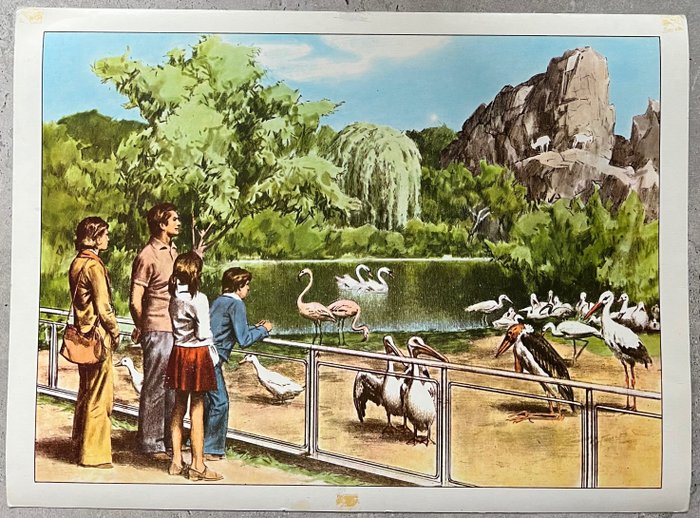
József Fogas - School education or work safety poster - lithography, Agriculture, tools, animals, rural, dwarf, - Jaren 1960
Nr. 83288227

Nr. 83288227

Very well preserved 100% original poster from the emblematic Kőbánya industrial district
Litography on thick paper - USSR
No other item of this available worldwide!
Fogas József, the late father of the person mentioned, was an outstanding boxer in the 1920s and 30s.
A few years after graduating, he successfully applied to the Applied Graphics Department of the Hungarian College of Applied Arts, specializing in typography and graphic design. He graduated as a designer artist in 1974. In 1970, he won a political poster competition, and his winning artwork could be seen on the streets. From 1970, he participated every two years in the Warsaw Biennale. As a result, Andy Warhol noticed his work in 1974 and invited him to an American exhibition. However, he couldn't attend because, according to the regulations at the time, he would have needed permission from the Hungarian National Bank to send his works, which he didn't receive.
He regularly designed book covers (for Magvető and Örkény series), film posters (Partisans, Love in the War), company logos, emblems (Bútorért), and took part in designing graphics for almost all Hungarian and foreign exhibitions organized by HUNGEXPO.
He was a member of the Hungarian Days in Hamburg held in 1982, for which the emblem was a cube in the shape of a hay bale (one of his professors at the college was Ernő Rubik). He was also part of the award-winning design collective for the OMÉK Exhibition and Fair. The emblem he designed for OMÉK served as the logo for the fair for many years. He worked in Plovdiv (hunting fair), Paris, Nitra, České Budějovice, London, Copenhagen, Kiel, Moscow, Klagenfurt, and Odessa. His last foreign assignment was in Salzburg in November 1985
-
About Hungarian Poster Art
Hungarian poster art has long been celebrated for its unique and captivating style, making it a significant cultural and artistic movement in the world. From the late 19th century to the present day, Hungarian poster art has left an indelible mark on the global art scene, with its innovative techniques, bold designs, and powerful messages.
One of the highlights of Hungarian poster art is its ability to seamlessly blend various artistic styles and influences. The movement drew inspiration from a wide range of sources, including Art Nouveau, Constructivism, and Surrealism, resulting in a diverse and eclectic body of work. Artists such as Mihály Bíró, József Bottlik, and István Irsai pushed the boundaries of traditional poster design, experimenting with typography, color, and composition to create visually striking and thought-provoking pieces.
Another notable aspect of Hungarian poster art is its emphasis on storytelling and narrative. Unlike many other countries' posters, which primarily served as advertising tools, Hungarian posters often conveyed a deeper meaning or social commentary. They were not just meant to sell products but also to engage viewers intellectually and emotionally. This storytelling approach allowed Hungarian poster art to transcend its commercial purpose and become a powerful medium for social and political expression.
The importance of Hungarian poster art in the world cannot be overstated. During the early 20th century, Hungary was at the forefront of graphic design, and its posters gained international recognition and acclaim. The Budapest School, a group of Hungarian artists, revolutionized the field with their avant-garde approach, influencing poster art movements across Europe and beyond. Their innovative techniques and artistic vision set new standards for poster design, inspiring generations of artists worldwide.
Furthermore, Hungarian poster art played a crucial role in shaping public opinion and mobilizing society. In times of political turmoil and social change, posters became a powerful tool for propaganda and activism. During World War II and the Hungarian Revolution of 1956, posters were used to rally support, convey messages of resistance, and document historical events. The ability of Hungarian artists to capture the spirit of the times and communicate complex ideas through visual imagery made their posters an integral part of the nation's cultural and political identity.
Today, Hungarian poster art continues to thrive, with contemporary artists carrying on the legacy of their predecessors. The Hungarian Poster Museum in Budapest showcases the rich history and evolution of this art form, attracting visitors from around the world. The enduring appeal and influence of Hungarian poster art can be seen in the works of renowned artists like Tibor Helényi and István Orosz, who have successfully merged traditional techniques with modern aesthetics.
In conclusion, Hungarian poster art stands as a testament to the country's artistic prowess and cultural heritage. Its unique style, emphasis on storytelling, and ability to provoke thought and emotion have made it an important and influential movement in the world. From its early beginnings to the present day, Hungarian poster art continues to captivate audiences and inspire artists, leaving an indelible mark on the global art scene.
—
Please note that our company was founded in 1994 and it is internationally trackable. Invoice is available upon request.
Our team consists of members with university degree of art, painting valuation experts and experienced art&antique dealers
Feel free to ask as much as you want. Lifetime warranty is available for all items originality.
Shipping is with insurance and in tube, rolled.
Zo koop je op Catawiki
1. Ontdek iets bijzonders
2. Plaats het hoogste bod
3. Veilig betalen